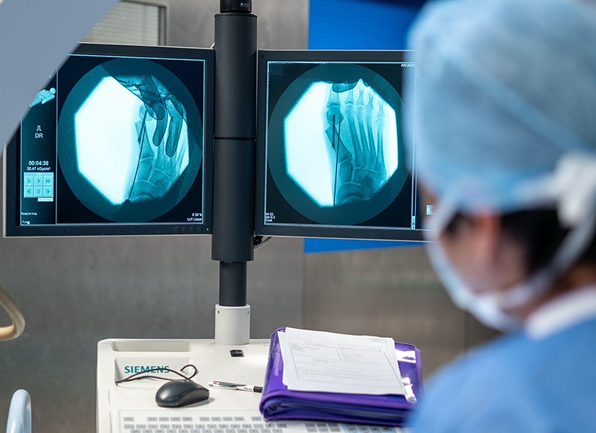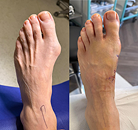Keyhole Bunion Surgery
What is Keyhole Bunion Surgery?
Keyhole bunion surgery is a modern technique to fix painful bunions without using a large incision to expose the bones before cutting and resetting them.
The surgeon will make tiny little holes through a very small cut, no more than 3 to 4 mm on the inside part of your foot.
The small incisions are used to be able to cut the bone involved in forming the bunion deformity. Using a specialised bur specifically made for keyhole bunion surgery. Once the bone is cut, it is reset under direct x-ray visualisation into the corrected position, thus reducing the deformity of the bunion and realigning the big toe in a straight position.
Specialised screws for bunion surgery are used to hold the bone in the new position whilst it heals.
All this is done through small incisions without exposing the bone and under direct X-ray visualisation.
The benefits of keyhole bunion surgery over traditional surgery are generally that you get much less post-operative pain. You can weight bear immediately with or without crutches in a specialised sandal.
Specialised screws for bunion surgery are used to hold the bone in the new position whilst it heals.
All this is done through small incisions without exposing the bone and under direct X-ray visualisation.
The benefits of keyhole bunion surgery over traditional surgery are generally that you get much less post-operative pain. You can weight bear immediately with or without crutches in a specialised sandal.
You will need to rest and elevate just like traditional surgery, but much less. There are less likely surgical wound problems, you are less likely to get joint stiffness and hence return to all sports and high heels without having the significant risk of joint stiffness with traditional surgery.
You can also correct the deformity when it comes to large bunions much more fully without a fusion procedure of the midfoot.
The risks of joint stiffness are also reduced due to early mobilisation. Physiotherapy is not necessary post-operatively, and the outcomes are more favourable than the traditional bunion techniques.

Why Choose Our Bunion Surgery?
- Minimal pain
- Small incisions
- Faster healing
- Less complications
- No hospital stay
Who is a Suitable Candidate?
Bunion surgery can be performed in most bunion deformities whether small or large. Typically, you will require good bone quality, so it is unsuitable for patients who have osteoporosis. This is due to the nature of the operation requiring small incisions and less exposure of bone, therefore the quality of bone is important to be able to manipulate and reset it.
Furthermore, if you have arthritis in the big toe joint, then you do have a chance of joint stiffness and not suitable for minimally invasive bunion surgery if this is significant. Those patients may need to opt for a more traditional operation such as a fusion operation.
Preparing for Keyhole Bunion Surgery - Procedure
Step 1
A small 2mm incision is made allowing the first metatarsal to be cut.

Step 2
The head of the first metatarsal is repositioned, to partially minimise the bony prominence.

Step 3
Two screws are used to fix both sections of the metatarsal in its new position.

Step 4
A wedge is removed from the first proximal phalanx to reposition the toe into a straighter alignment. This is also fixed in place with a screw.

Step 5
The protruding bone is cut away and flattened to a natural outer arc.






Week by Week Recovery
It is important to rest as much as possible with the leg elevated for the first 3 days.
Between 3-14 days mobilise up to 10 mins an hour with the use of crutches and a post-operative shoe.
An in person appointment for suture removal will be arranged, absorbable sutures may be used during the surgery.
At this stage, you should be able to move into sandals or rigid sole trainers.
Four weeks following surgery you can increase activity to 30 mins an hour and can start to drive.
Six-eight weeks review in clinic with X-rays, high impact activities can continue.
High heels can typically be worn at 3 months post-op, tighter heels may not be possible until 4 months.

Cost & Insurance for Keyhole Bunion Surgery
Self-funding Patients
For self-funding patients we have the below fees for the minimally invasive bunion surgery:
Following surgery further X-rays will be carried out.
Insured Patients
Minimally invasive keyhole bunion surgery can also be covered by medical insurance.
Initially, contact your insurance provider to request authorisation for a consultation with Mr Kaser Nazir and X-rays. Typically insurance companies will request a referral letter from your GP.
Following your appointment, our team will provide you with details on how to authorise the procedure.
Frequently Asked Questions
Before and After Keyhole Bunion Surgery

Bunion and toe correction

Bunion and toe correction

Before and After Bunion Surgery

Before and After Bunion Surgery

Hallux Valgus Surgery - Before and After

Bunion Correction - Before and After Surgery

Scarf and Akin Osteotomy - pre and post surgery

Before and After Bunion Surgery

Before and After Hallux Valgus Surgery

Bunion, Tailor's Bunion and Hammertoe Surgery - Before and After

Hallux Valgus Surgery - Before and After

Bunion Surgery - Before and After

Before and After Hallux Valgus Surgery

Before and After Bunion Surgery

Hallux Valgus Surgery - Before and After

Bunion Surgery - Before and After

Bunion Correction Surgery - Before and After

Hallux Valgus Surgery - Before and After Procedure

Bunion Correction - Before and After Surgery

Mini Scarf Procedure - Before and After Surgery

Bunion Correction - Before and After Surgery

Bunion Correction - Before and After Surgery

Hallux Valgus Correction - Before and After

Bunion Surgery - Before and After

Bunion Surgical Correction - Before and After

Bunion Correction - Before and After Surgery

Bunion + Tailor's Bunionette Correction, as well as 4th-5th Toe Separation

Bunion Corrective Surgery - Before and After

Bunion Surgery - Before and After Surgery

Bunion Surgery - Before and After Surgery

Bunion Correction - Before and After Surgery

Bunion Correction - Before and After Surgery

Bunion & Hammertoe Correction - Before and After Surgery

Bunion Correction Surgery - Before and After Surgery

Bunion Correction - Before and After Surgery

Bunion Correction - Before And After Surgery

Bunion Correction - Before And After Surgery

Bunion and Hammertoe Correction - Before & After Surgery

Bunion Correction - Before And After Surgery

Bunion Correction - Before And After Surgery

Bunion Correction - Before And After Surgery

Bunion Correction - Before And After Surgery

Bunion Correction and Toe Shortening - Before and After Surgery

Bunion Correction - Before And After Surgery

Bunion and Hammertoe Correction - Before and After Surgery

Bunion and Toe Correction - Before and After Surgery

Bunion Correction - 3 Months Before & After Surgery

Bunion Correction - Before and After Surgery

Bunion Correction - Before and After Surgery

Bunion Correction - Lapidus Procedure - Before After Surgery

Bunion Correction - Scarf & Akin Osteotomy - Before After Surgery

Bunion Correction with removal of damaged big toenail - Before and After Surgery

Bunion Correction - Before and 18 Months After Surgery

Bunion Correction - Before and After Surgery

Bunion Correction - Before and After Surgery

Bunion Correction - Before and After Surgery

Bunion Correction - Before and After Surgery

Bunion Correction - Before and After Surgery

Bunion Correction - Before and After Surgery

Bunion Correction - Before and After Surgery

Bunion Correction - Before and After Surgery

Bunion Correction - Before and After Surgery
Blogs

Minimally Invasive Bunion Surgery
Keyhole Bunion Surgery or Minimally Invasive Bunion Surgery Minimally Invasive...
KNOW MORE
Bunion Surgeon London – Mr. Kaser Nazir
Kaser Nazir, is a specialist foot surgeon who performs at...
KNOW MORE
Bunion Surgery Recovery Tips Week by Week
Bunion Surgery A Bunion is a common foot deformity that...
KNOW MORE
Bunion Surgery in Dubai
Bunion surgery for corrective bunion operation is available in Dubai....
KNOW MORE

Bunions: Diagnosis, Cause and Treatment
What Causes Bunions A Bunion is a common foot complaint,...
KNOW MORE
Is Summer the Best Time to Have Bunion Surgery?
All bunion specialists now agree that whilst bunion corrector type...
KNOW MORE
Mr. Kaser Nazir
Consultant Podiatric Surgeon
Mr. Nazir is a Consultant Podiatric Surgeon with more than 20 years NHS experience. He was appointed as an NHS Consultant Podiatric Surgeon and departmental lead at Guys & St Thomas’ NHS trust and performs reconstructive and corrective foot and ankle surgery. He also leads departmental audit & research ensuring that the department is consistent in providing a modern and high quality foot and ankle service. He is also the incumbent Dean of the Faculty of Podiatric Surgery in the United Kingdom in 2021.




